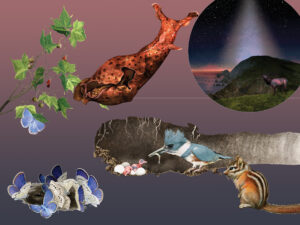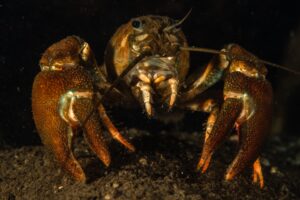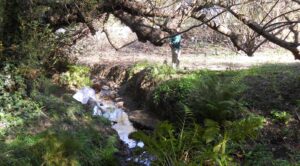Durrell Kapan keeps checking his Yeti cooler of 13 butterflies. He caught them yesterday at Garrapata State Park, and checked into a seaside motel for the night, where he fed them a nectar-like solution that’s been found most amenable to sustaining butterflies: Fruit Punch-flavored Gatorade. This morning on his way to Monterey, he stopped at the convenience store and stocked up on fizzy water to help regulate the temperature inside the cooler. Ice would be too cold, but a little chill keeps them calm.
Feeding butterflies in a motel room is not, strictly, Kapan’s job, which involves crunching large data sets related to insects, genomics, and biodiversity, as a senior research fellow at the California Academy of Sciences. But he loves fieldwork, and four years ago, the Academy got a phone call.
It was from Revive and Restore, a Sausalito-based nonprofit founded by Stewart Brand and Ryan Phelan, best known for its ambitious goal to resurrect extinct species like the wooly mammoth and the passenger pigeon. Would the California Academy be interested in using some of the DNA in its collection to sequence the genome of an extinct butterfly?
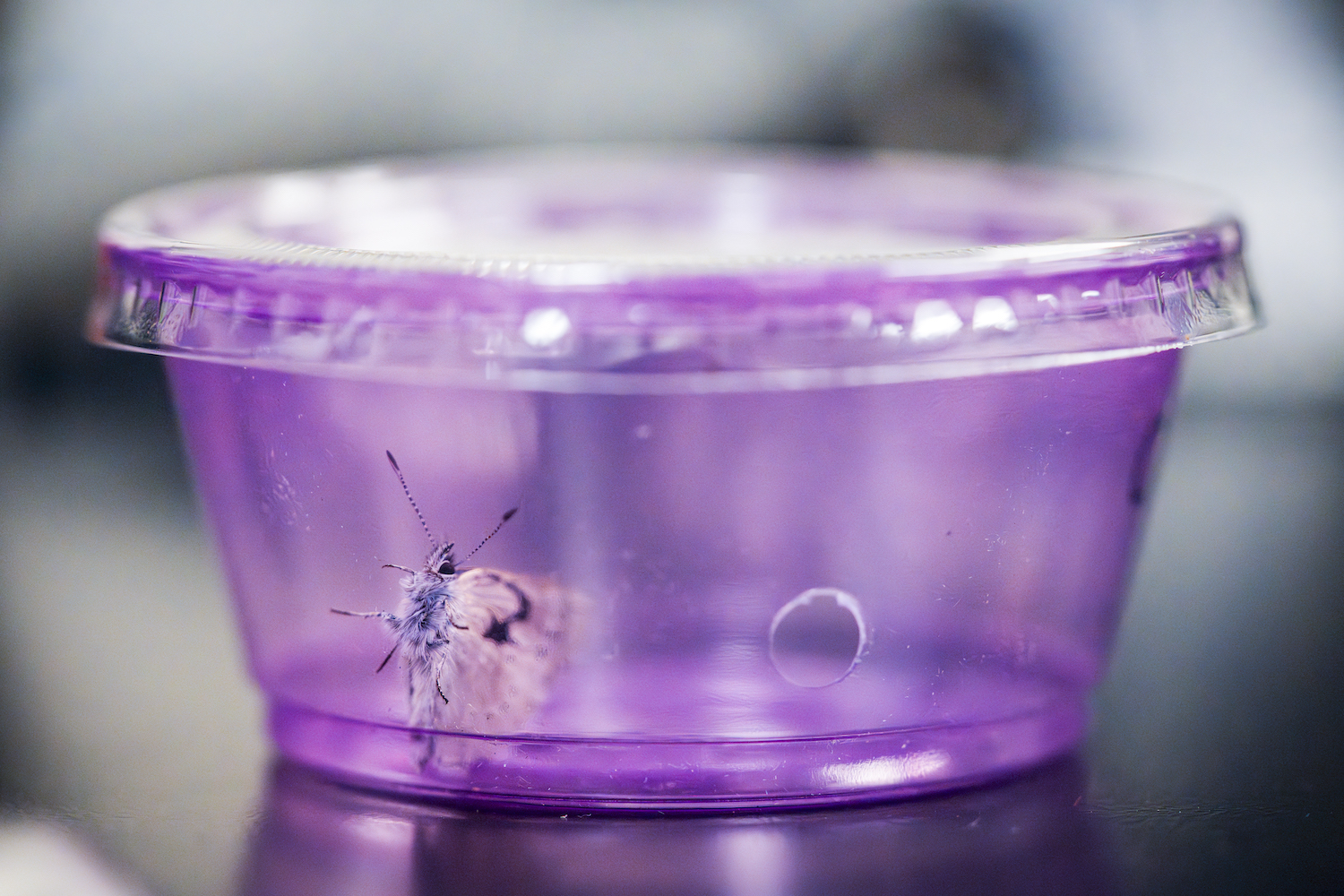
Kapan jumped at the opportunity. He’d fallen in love with butterfly ecology years ago, but scaled that back to focus on what felt like more critical work—the connection between biodiversity and resilience. Increasingly, the study of biodiversity felt less like an intellectual playground and more like a library of survival. “We don’t know yet what species or what gene is going to be important,” says Kapan. “The only logical thing to do is to prioritize conserving and regenerating as much of nature as possible.”
The butterfly that Revive and Restore was interested in was the Xerces blue butterfly—Glaucopsyche xerces. It is famous in the way that no one wants to be famous. Once common in the miles of sand dunes that ran along the western edge of San Francisco, it became harder and harder to find as the dunes were replaced with housing and other development in the early 20th century. William Hovanitz—a local entomologist—regularly biked out to the Presidio military base to study one of the species’ last populations. He tried to sweet-talk the Presidio commander into leaving their habitat undisturbed, which worked until it didn’t. The last few were spotted in 1943, fluttering in the dunes above Lobos Creek. Not long after, the army bulldozed the dunes and covered them with gravel. No one reported seeing one again. It became the first insect extinction in North America that humans are known to have caused.
But the Xerces continued to haunt the memories of those who had seen and heard of it. In 1971, a lepidopterist named Robert Michael Pyle attended a lecture about a butterfly in England that was hovering on the edge of extinction. “If we lose our large blues,” said the speaker, “let us make them a symbol for vigilance, so that we shall never see another British butterfly become extinct if we can help it to survive.” On the train home, Pyle found himself thinking about another blue butterfly. The Xerces was already extinct. It was a real species that had lived, flourished, and died, leaving behind the makings of a killer logo: the “X” in its name could be a stand-in for extinction, and be made to look like the silhouette of a butterfly. It could be a symbol for vigilance right away. A few weeks later, Pyle founded the Xerces Society, which became one of the best-known conservation organizations dedicated to protecting insects and their habitat.
Butterfly habitat began returning to San Francisco in the 1990s, when the U.S. government closed the Presidio as a military base and turned the property over to the U.S. National Park Service and a newly created federal agency called the Presidio Trust. The park service almost immediately began demolishing housing on the bluffs over Baker Beach and replacing them with sand dunes, and restoring the area around Lobos Creek. As the Trust and the NPS restored habitat, they began bringing back in species. They brought in caterpillars of the variable checkerspot butterfly, which had gone extinct in the Presidio in the 1970s, from San Bruno Mountain, and California ringlets, another butterfly, from the Marin Headlands. They brought in Western pond turtles from Lake County, and began plotting to restore the California quail.
Sign up today!

The California Academy of Sciences had one of the last Xerces blue specimens ever captured pinned in a box in their archives. They had been netted near Lobos Creek in 1941, by an entomologist who never stopped expressing regret over the dubious fame this brought him. And they had hundreds more—remnants of the Victorian-era craze for butterfly collecting.
Cal Academy began sequencing the genomes of the Xerces specimens it had. It wasn’t the first time researchers had tried this, but it resulted in the most complete sequences to date.
Still, the DNA was degraded—a problem that’s been universal so far among attempts to sequence extinct species’ DNA. In other Revive and Restore-funded projects, like the mammoth one, scientists try to compensate for that degradation by sequencing the genome of the species’ closest living relative and using it as something like a blueprint—employing the gene editing technology Crispr-Cas9 to alter live cells from the non-extinct species into something more closely resembling the extinct one.
That was not what Revive and Restore was trying to pull off this time. Instead, they had begun working with the Presidio Trust on a much more affordable and pragmatic plan—use DNA sequencing to identify Xerces’ closest living relative, and then help that relative repopulate the Presidio’s restored dunescapes.
This idea had been circulating for a while. In a 2000 essay titled, “Resurrection Ecology: Bring Back the Xerces Blue!” Pyle noted that a subspecies of the silvery blue butterfly (Glaucopsyche lygdamus) living in Southern California, on Santa Rosa Island, looked remarkably like the extinct Xerces.
As a species, the silvery blue had a deep genetic well to draw from—different varieties can be found coast-to-coast in North America from Nantucket to Nome. The Xerces and silvery blue split off from a common ancestor around a million years ago, and the silvery blue butterfly had existed in San Francisco before going locally extinct in the 20th century. While no records showed that the silvery blue had lived in the Presidio, it was possible that if a subspecies that was adapted to the local climate could get an ecological foothold in the newly re-established dunes, they might evolve over time into something like the Xerces.
MORE READING
From the Bay Nature archives
In the Shadow of the Xerces Blue
San Francisco tries to change the conditions that once made it famous for butterfly extinction.
“San Francisco is more famous for what no longer flies here than for what still flies,” writes lepidopterist Liam O’Brien.
That is how Kapan came to be at Fort Ord Natural Reserve, just north of Monterey, on the second day of a butterfly-gathering expedition. A wildlife ecologist for the Presidio Trust named Phoebe Parker-Shames is there to help, along with Felicia Jimenez, a digital engagement specialist from Cal Academy. All three are walking very slowly and carrying butterfly nets. The cooler is inside Kapan’s car, parked under the shadiest tree he could find. Both Kapan and Parker-Shames are wearing insulated fanny packs to protect any silvery blues they catch.
This section of Fort Ord—another military base decommissioned in the 1990s—is a habitat research area managed by UC Santa Cruz, closed to nearly everyone except for researchers or the occasional school group. To get here, Kapan had to apply for a research permit. It is home to several endangered species, including a very small pink flower called the Monterey gila, which it is forbidden to step on. This is tricky, because the flower is everywhere, as thick as a carpet in some places. “Many military bases, by virtue of having a fence and keeping most people out, are great places for nature to hang on,” Kapan says. In the distance is something that sounds like gunshots but is probably some system meant to keep birds away from a nearby airport. There’s a skydiving business nearby, and Kapan can sometimes hear the sound of distant whooping.
The silvery blue is not easy to spot—it’s about the size of a nickel, and females in this area tend towards a muted pewter color. These silvery blues weren’t the closest genetic match to the Xerces. But they were the closest match that happened to be living in a landscape like the one where Xerces once thrived, in terms of climate, habitat and host plant. Genetics aren’t everything, and the Presidio, with its high winds and cold foggy nights, is a tricky spot to be a butterfly.
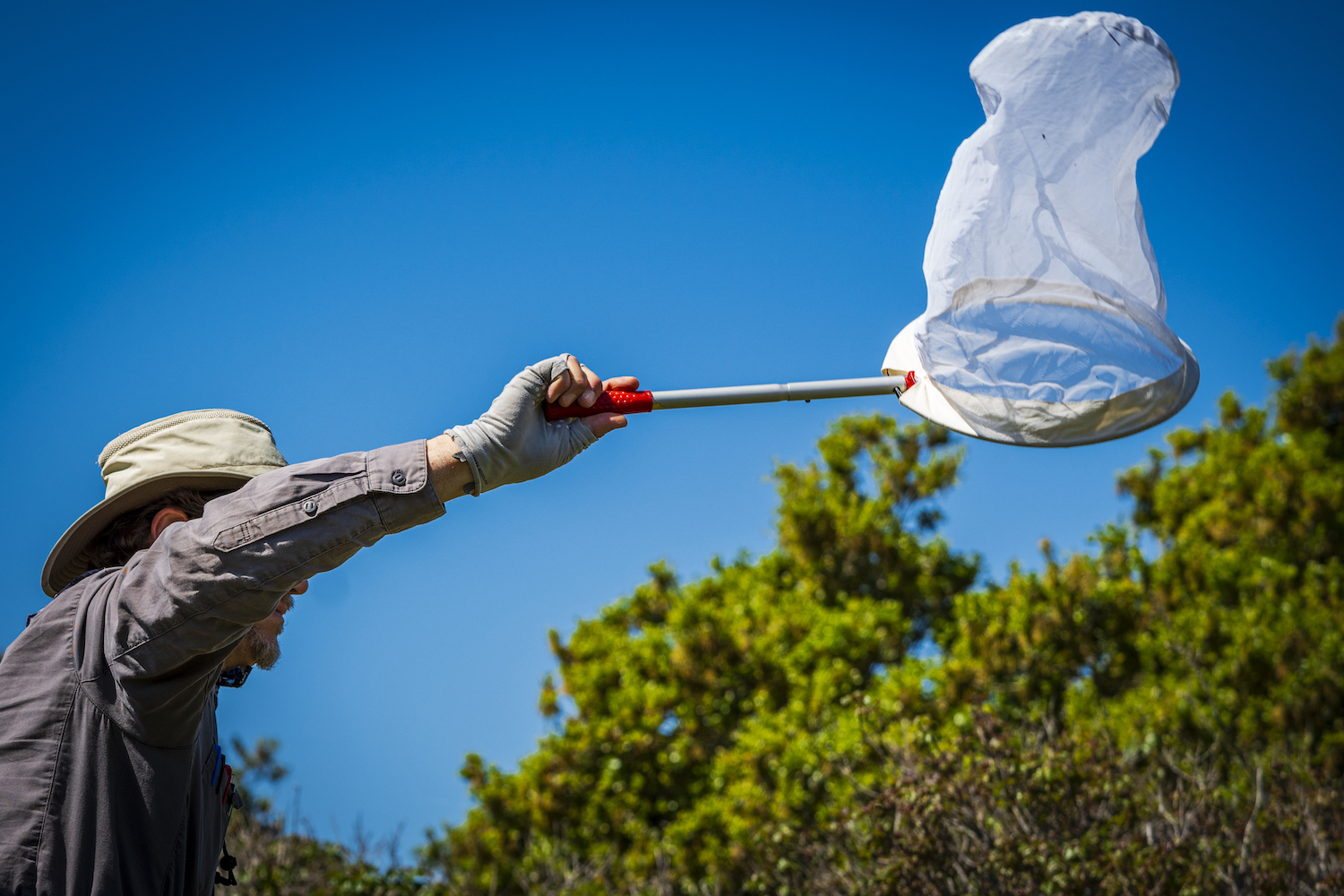
The collectors walk several feet behind Dean Meiman, an undergraduate from UC Santa Cruz who is wearing a trucker hat emblazoned with an obscure Pokemon. Whenever Meiman spots a silvery blue, he stops for several minutes to input data—GPS location, temperature, wind speed, cloud cover—into multiple devices. He drives down here twice a week to follow a fixed survey route through the area. By the end of May, he’ll have collected the most complete data set in existence on their population here. “Dean has to stay in front,” says Kapan. “We don’t want to Heisenberg his data.”
Capturing silvery blues at the caterpillar stage, when they are more slow-moving, is not an option—the caterpillars are nearly impossible to find. Like the Xerces, these silvery blues have a symbiotic relationship with ants, which protect their larvae in exchange for the privilege of drinking their secretions, as though they were little cows. That means that by the time it’s big enough to be spotted, a silvery blue caterpillar is down on the sand being farmed.
The data, and the collecting, are also complicated by the fact that the male silvery blues are both easier to spot—brilliant blue, and flitting around everywhere—and less suited to the task at hand. This is a lady butterfly mission—for it is the lady butterflies that will, if captured and relocated to the Presidio, hopefully lay their eggs on the tender inner leaves of the deerweed that has been planted on the dunes for their benefit. A few male butterflies are being nabbed, but only for the purposes of fertilizing any females who might not have mated before getting caught.
It takes hours to capture 15 more butterflies. Kapan gently places each one into an individual plastic container of the sort commonly used for to-go portions of salsa, and marks the outside with the time caught, and the GPS coordinates of where it was captured. Seen up close, the silvery blues have chunky little white bodies, like miniature yetis. Into the cooler the containers go, next to the 13 from Garrapata, and Kapan begins the long drive back.
In the car, Kapan gets a call from his wife, Shannon Bennett, who also happens to be Cal Academy’s chief of sciences. “Should I warm up the Gatorade?” says Bennett, excitedly.
Kapan tells her that he feels like Santa, driving a sleigh filled with butterflies. “Don’t take any sharp turns,” says Bennett. That night in Mill Valley, Bennett and Kapan soak Q-tips in Gatorade and use them to feed the 28 butterflies in their kitchen. They mark the creatures’ wings gently with rainbow Sharpies, from a bag marked with a biohazard symbol to make sure the markers aren’t used for anything else. It’s after midnight by the time they finish. They put the Gatorade in the fridge with “Butterflies” scrawled along the side in magic marker, so that their teenage daughter won’t drink it.
The next morning is the butterfly press conference. Kapan and Bennett haul equipment up the path to one of the Presidio’s restored sand dunes—a former cemetery for merchant marines that the army turned into a dump for lead-contaminated construction materials. In the 2000s, when a parking garage was being dug out under the California Academy, the excavated sand was trucked out here and planted with deerweed, lupine, and other local native plants.
Kapan sprays the soles of his shoes with alcohol to sterilize them, and carries the cooler into the dunes, where a team from the National Park Service, the Academy, and the Presidio Trust are unwinding sheets of tulle, the gauzy fabric used in tutus. They lay the sheets over the deerweed, and weigh down the edges with any sticks and rocks they can find nearby. The plan is to release the butterflies under the tulle, so that they will hopefully lay some eggs on the deerweed before being exposed to the wild world of the Presidio. “I’m probably going to move those butterflies after the press conference,” says Kapan, gesturing towards some tulle that is being set up close to the boardwalk, in front of a nice photo-op of the Sutro Tower. “I’ve seen some swallows that like to fly along here really fast.” Kapan checks the temperature inside the cooler for the approximate billionth time. “Thirteen degrees,” he says, with great satisfaction. “Centigrade.”

A group of photographers arrive in a rush, right as the press conference is supposed to start. “Very narrow escape,” says one. “OJ Simpson just died. But we’re here.” They crouch around Kapan, shutters clicking, as he begins a speech about the Xerces blue—how the last one took its last flight over eighty years ago near here, and how a large and disparate team—the Academy, the Presidio Trust, the park service, the local ecological outfit Creekside Science, Golden Gate National Recreation Area, and Revive and Restore—joined forces to bring in “an ecological surrogate, or stand-in, to stand in the big shoes of Xerces.” At this moment, cheesy pun and overwhelming emotion collide. Kapan tears up and turns away from the cameras to compose himself.
On the nearby boardwalk, hikers stop and stare. The release is being kept secret for a few days, out of the worry that curious visitors might inadvertently step on eggs laid on the deerweed, or otherwise disturb the butterflies. Already, when Kapan was doing a trial release a week earlier, two off-leash dogs ran under the boardwalk fence and through the area where Kapan had just placed a few butterflies. When he told the dog’s owner that he needed to be more careful, the owner glared at him like he’d just been challenged to a bar fight. None of that is in evidence today, possibly due to the conspicuous presence of an NPS official in full hat and uniform.

One by one, the silvery blues are released from their salsa containers inside the netting. They flutter around frantically at first, then settle on the deerweed. The camera crews hover over them, telephotos extended.
Some species reverberate across an ecosystem. Others have an impact that’s harder to see. When coyotes trotted across the Golden Gate Bridge in 2002 and re-inhabited the Presidio, they set off a chain of events that continues to reshape the local ecology. If the silvery blues do manage to gain a foothold in the Presidio, they may help spread the deerweed and the other plants they feed on. They may give the native ants an edge over interloping Argentine ant populations—surveys of ants in the Presidio show that native ants are still around.
This project cost about $100,000, not counting the researchers’ salaries, Kapan estimates (the project was funded in part by a Disney Butterfly Conservation Initiative to the University of Florida, along with Presidio and Academy support). That’s maybe a tenth of what it would have cost to try to breed silvery blue butterflies into something close to Xerces, and an even smaller fraction of what trying to de-extinct Xerces with Crispr-Cas9 might have. The genetics are getting cheaper fast. But even trying to replace each and every missing species in an ecosystem like the Presidio would be financially staggering.
Whether this particular attempt to repopulate the Presidio with blue butterflies succeeds, says Kapan, Xerces has already changed the world around it. It went extinct because its habitat was destroyed. But just the memory of Xerces, and other lost species like it, is bringing those ecosystems back, at least in part. In the meantime, these butterflies exist—a quick flash of blue, against a wide and ever-changing horizon.


